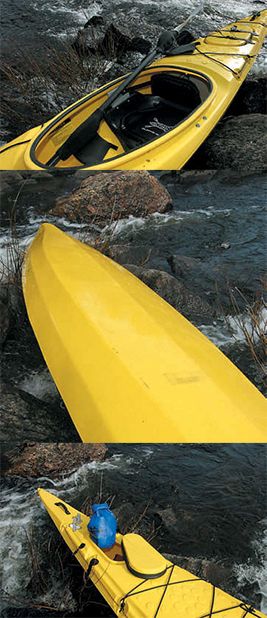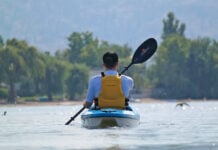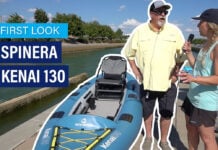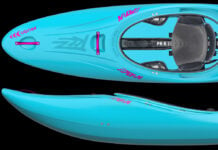The Quest is built by the three-year-old touring kayak division of an Ontario canoe company, Nova Craft, so we thought ours might feel at home in some classic canoe territory. We joined our sister publication, Rapid magazine, on a whitewater kayak test day for an early spring high-water run through Lower Madawaska Provincial Park, not far downstream of where the Madawaska River flows past our offices.
Normally home to Royalex whitewater canoes and stubby freestyle kayaks, the Mad doesn’t see many touring kayaks, but why not? Fourteen and 15-foot touring kayaks overlaps whitewater slalom boats in length, and a few companies sell kayaks of this length as “hybrids” for use on everything from oceans and large lakes to pokey streams and river whitewater up to Class III and IV.
Aquafusion Quest Specs
Length: 14′ 8″
Width: 23.5″
Depth: 11.5″
Cockpit: 31″ x 16.5″
Weight: 57 lbs
MSRP: $1,099 CDN base; $1,299 CDN GT
Not that many among you paddlers of recreational touring kayaks are planning to take your boat downriver in April, but since we wanted to test Aquafusion’s claim that the Quest is “sleek and fast yet highly manoeuvrable and carves turns on the lean effortlessly,” putting it through the whitewater paces seemed like a sure way to find out.
The Lower Mad consists of a series of about a dozen Class II to IV rapids with some long stretches of flatwater, dealing us everything from glassy calm to chop, rock gardens and steep, breaking surf.
Paddlers in the Quest had more fun than the river kayakers. The Quest catches waves and surfs beautifully, dials carving turns with a quick roll of the hips, Eskimo rolls capably despite rudimentary cockpit outfitting and blasts across eddylines with more speed than anything else on the river.
The multi-chine hull sits almost more comfortably in a tilt than it does flat, so beginners may find it a bit wobbly and skittish unloaded in big water. Being easy to tilt, the Quest is a great boat for the keen beginner to learn edging and bracing techniques.
With the hull-design characteristics of a high-end kayak built into a recreationally priced boat, you sacrifice some higher-end comforts like dependably water-tight hatches, a foot-controlled rudder and stock-outfitted thigh and hip braces—but receive performance that lives up to its billing, without the inaccessible bill. A great learning boat suitable for shorter trips.
Cockpit and rear deck (top)
For a boat that you’ll be tilting a lot, customizing the interior is a must. The seat comes with a cushy pad underneath and an adjustable North Water backband. The aluminum seat stays are awkwardly placed and require some adjustment and extra padding. The Quest also requires knee/thigh pads—they’d be easy to glue to the flat under-deck.
Classic multi-chine (middle)
The multi-chined hull is a proven performance design that’s remarkably similar to some others. If you’ve seen a 14-foot Necky Looksha, you’ve essentially seen the hull on the Quest. In a strong wind, the Quest is remarkably well balanced, tracking well with no strong tendency to weathercock, making the optional aluminum skeg, well, optional! A nylon cord on a cleat drops the skeg, which protrudes somewhat alarmingly from the stern of the Quest when not in use—don’t forget your red flag when cartopping!
Love handles (bottom)
Our BCU teachers would rap our knuckles, but we couldn’t help loving the padded handles bolted onto the front and rear decks of the Quest: top marks for carrying comfort. For an additional $200 CDN, the GT package comes with the skeg, front bulkhead and storage hatch shown here—useful if you’re planning to do any tripping, but the hatch opening is small and not 100-percent waterproof. Consider stuffing a drybag or flotation into the bow of the standard model. The deck is flat and streamlined, Greenland-style, and surfs and sheds water remarkably well given its knife-like profile.










